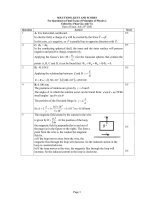final exam 20222 ee2023 technical writing and presentation
Bạn đang xem bản rút gọn của tài liệu. Xem và tải ngay bản đầy đủ của tài liệu tại đây (342.41 KB, 16 trang )
<span class="text_page_counter">Trang 1</span><div class="page_container" data-page="1">
<b>HANOI UNIVERSITY OF SCIENCE AND TECHNOLOGYSchool of Electrical and Electronic Engineering</b>
<b>Department of Automation Engineering</b>
<b> Final Exam 20222 </b>
<b> EE2023 Technical Writing and Presentation</b>
Student name: Tran Dinh Hoan Student ID: 20210362 Class ID: 140887
Hanoi, 7/2023
</div><span class="text_page_counter">Trang 2</span><div class="page_container" data-page="2"><b> SUMMARY </b>
This study provides a comprehensive overview of the synthesis,characteristics, and applications of nanoparticles (NPs) in various forms. NPsare extremely tiny materials with sizes ranging from 1 to 100 nm. They canbe divided into many classes based on their qualities, forms, and sizes.Fullerenes, metal NPs, ceramic NPs, and polymeric NPs are the variousgroups. Because of their large surface area and nanoscale size, NPs havedistinct physical and chemical characteristics. Their optical properties aresaid to be size dependant, imparting distinct hues due to absorption in thevisible area. Their distinctive size, shape, and structure also influence theirreactivity, toughness, and other qualities. They are good candidates for avariety of commercial and domestic applications, including catalysis,imaging, medicinal applications, energy-based research, and environmentalapplications, due to these features. Heavy metal NPs of lead, mercury, and tinhave been observed to be so stiff and stable that decomposition is difficult,which can lead to a variety of environmental toxicities.
2
</div><span class="text_page_counter">Trang 3</span><div class="page_container" data-page="3">CHAPTER 2 SYNTHESIS OF NANOPARTICLES………...6
CHAPTER 3 CHARACTERIZATION OF NANOPARTICLES…..7
I.Morphological characterization……….7
II.Structural characterization……….9
III.Particle size and surface area characterization………..9
IV.Optical characterization……….10
CHAPTER 4 PHYSICOCHEMICAL PROPERTIES OFNANOPARTICLES………10
I.Electronic and optical properties………..…10
II.Magnetic properties………..…10
III.Mechanical properties………..11
IV.Thermal properties………12
CHAPTER 5 APPLICATIONS OF NANOPARTICLES ………….12
I.Applications in drugs and medications……….12
II.Applications in manufacturing and materials………...12
III.Applications in the environment………...13
IV.Applications in electronics………13
V.Applications in energy harvesting………13
VI.Applications in mechanical industries………..13
3</div><span class="text_page_counter">Trang 4</span><div class="page_container" data-page="4">CHAPTER 6 TOXICITY OF NANOPARTICLES………...14CONCLUSION………..15REFERENCES ………..16
Nanotechnology has been studied since the last century. Since Nobel laureate Richard P.Feynman introduced the term "nanotechnology" in his well-known 1959 lecture "There's Plentyof Room at the Bottom" (Feynman, 1960), there have been numerous significant developmentsin the field of nanotechnology. Nanotechnology created a wide range of materials at thenanoscale level. Nanoparticles (NPs) are a broad class of materials that include particulatecompounds with a maximum size of less than 100 nm. These materials can be 0D, 1D, 2D, or 3Ddepending on the overall shape. The significance of these materials was apparent whenresearchers discovered that size can influence a substance's physiochemical qualities, such asoptical capabilities. The hues of 20-nm gold (Au), platinum (Pt), silver (Ag), and palladium (Pd)NPs are wine red, yellowish gray, black, and dark black, respectively. An example of thisrepresentation, in which Au NPs of varying sizes are synthesized. These NPs displayed distinctcolors and properties with varying size and shape, which can be used in bioimaging applications.The hue of the solution changes due to variations in aspect ratio, nanoshell thickness, and % goldconcentration, as scientists reveal. A change in any of the factors mentioned above affects theNPs' ability to absorb light, leading to the observation of various absorption hues.
Because NPs are not simple molecules, they have three layers: (a) the surface layer, which canbe functionalized with a range of small molecules, metal ions, surfactants, and polymers. (b) Theshell layer, which is chemically distinct from the core in all aspects, and (c) the core, which is theNP's central section and commonly refers to the NP itself. Because of their extraordinaryproperties, these materials have piqued the curiosity of researchers across multiple disciplines .The images of mesoporous and nonporous methacrylatefunctionalized silica (MA-SiO2)obtained using scanning electron microscopy (SEM)[1] and transmission electron microscopy(TEM)[2] are incredible. Mesoporousness gives NPs extra properties. The nanoparticles can beused for medication administration, chemical and biological sensing, gas sensing, CO2 capture,and other applications. We present a basic overview of the many types, synthesis methods,characterizations, characteristics, and uses of NPs in this review paper. The final portion includesfuture implications and recommendations.
We present a basic overview of the many types, synthesis methods, characterizations, characteristics, and uses of NPs in this review paper. The final portion includes future implications and recommendations.
<b>CHAPTER 1 CLASSIFICATION OF NANOPARTICLES</b>
4
</div><span class="text_page_counter">Trang 5</span><div class="page_container" data-page="5">Nanoparticles are classified into several types based on their form, size, and chemical characteristics. Some well-known classes of NPs are listed below based on physical and chemical properties.
I. Cacbon-based Nanoparticles
Fullerenes[3] and carbon nanotubes (CNTs)[4] are the two most common types of based NPs. Fullerenes contain nanomaterials made of globular hollow cages, such as allotropiccarbon forms. They have sparked significant commercial interest in nanocomposites for a varietyof commercial uses, including fillers, effective gas adsorbents for environmental remediation,and support medium for various inorganic and organic catalysts.
nanotechnology.
5
</div><span class="text_page_counter">Trang 6</span><div class="page_container" data-page="6">
Carbon nanotubes (CNTs)[4] are carbon tubes with diameters in the nanometer range (nanoscale). They are a type of carbon allotrope. Because of their nanostructure and the strength of the connections between carbon atoms, carbon nanotubes can display amazing features such as exceptional tensile strength and thermal conductivity. Some carbon nanotube formations are electrically conductive, whereas others are semiconductors. They can also be chemically changed. These features are projected to be useful in a wide range of technological applications, including electronics, optics, composite materials (replacing or supplementing carbon fibers), nanotechnology, and other materials science applications.
II. Metal NPs
Metal precursors make up the whole structure of metal NPs. Due to their well-known localized surface plasmon resonance (LSPR)[5] characteristics, these NPs have unique optoelectrical characteristics. Nanoparticles of Cu, Ag, and Au have a broad absorption band in the visible region of the electromagnetic spectrum. Modern cutting-edge materials require the controlled synthesis of metal NPs by facet, size, and shape. A wide range of scientific domains use metal NPs because of their exceptional optical properties. For SEM[1] sampling, gold NPs coating is frequently used to enhance the electrical stream and produce SEM[1] images of greaterquality. The applications section of this evaluation covers a wide range of other uses in detail.III. Ceramics NPs
Inorganic nonmetallic solids called ceramic NPs are created through heating and cooling. Amorphous, polycrystalline, dense, porous, and hollow variants are also available. These NPs aregaining a lot of attention from scientists due to their applicability in processes like catalysis, photocatalysis, dye photodegradation, and imaging.
IV. Semiconductor NPs
Because semiconductor materials have properties that fall somewhere between those of metals and nonmetals, they are used in a variety of ways in the literature. Large bandgaps in semiconductor NPs led to drastic changes in their properties during bandgap tuning. They are essential components of photocatalysis, photonics, and electrical devices as a result. For instance,a variety of semiconductor NPs have been shown to be highly effective in water splitting applications due to their ideal bandgap and bandedge positions.
V. Polymeric NPs
6
</div><span class="text_page_counter">Trang 7</span><div class="page_container" data-page="7">organic-based NPs. They typically have the shape of nanospheres or nanocapsules. The other molecules are adsorbed at the outside edge of the spherical surface, whereas the former are matrix particles with a typically solid total mass. In the latter case, the particle completely encloses the solid mass. PNPs are versatile and have many uses since they are simple to functionalize.
VI. Lipid-based NPs
These NPs include lipid moieties and have a wide range of biomedical uses. A lipid NP typically has a diameter of 10 to 1000 nm and is spherical in shape. Like polymeric NPs, lipid NPs feature a solid lipid core and a matrix made of soluble lipophilic substances. The outer core of these NPs was kept stable by the addition of surfactants or emulsifiers. Lipid nanotechnology is a sector of nanotechnology that focuses on the design and manufacturing of lipid nanoparticlesfor a range of functions, such as drug transporters and delivery systems and RNA release in cancer therapy.
<small>Scheme 1. Typical synthetic methods for NPs for the (a) top-down and (b) bottom-up approaches.</small>
<b>CHAPTER 3 CHARACTERIZATION OF NPS</b>
Different characterization techniques have been practiced for the analysis of variousphysicochemical properties of NPs. These include techniques such as X-ray diffraction (XRD),
7
</div><span class="text_page_counter">Trang 8</span><div class="page_container" data-page="8">(BET), and particle size analysis.
I. Morphological characterizations
Since morphology always determines the majority of the NPs' qualities, the morphological characteristics of NPs always garner significant interest. There are various methods for characterizing morphological investigations, but the most crucial ones are microscopic methods like polarized optical microscopy (POM)[7], SEM[1], and TEM[2].
The SEM[1] approach, which is based on the electron scanning concept, gives all the information that is currently known about the NPs at the nanoscale level. There is a large body ofresearch using this technique to examine the dispersion of NPs in the bulk or matrix as well as the morphology of their nanomaterials. Through the use of this approach, the dispersion of SWNTs[8] in the polymer matrix of nylon-6 and poly(butylene) terephthalate (PBT) was discovered. In addition, the same group offers a POM analysis of their materials, which revealed star-like spherulites of the produced materials, whose size was reduced with the incremental filling of SWNTs.[8]
Figure 7. SEM images of ZnO modified MOFs at different temperatures .
Similar to this, because TEM is based on the electron transmittance principle, it may provideinformation on the bulk material at magnifications ranging from extremely low to high. Thismethod is used to study the various morphologies of gold nanoparticles (NPs). Fig. 8 showssome TEM micrographs of distinct gold NP morphologies made using various techniques.Additionally, TEM offers crucial details regarding materials with two or more layers, such as thequadrupolar hollow shell structure of Co3O4 NPs. These NPs were discovered to be incrediblyactive in Li-ion batteries as anodes (Fig. 9). With sufficient pore space to buffer the volume
8
</div><span class="text_page_counter">Trang 9</span><div class="page_container" data-page="9">cycling performance, a higher rate capacity, and a higher specific capacity as well.
Figure 8. TEM images of different form of gold NPs, synthesized by different techniques
Figure 9. SEM (a–c, h), TEM (d–f), XRD patterns (g) and HRTEM (i) images of double, tripleand quadruple Co<small>3</small>O<small>4</small> hollow shells.
II. Structural characterizations
The structural characteristics are of the primary importance to study the composition and natureof bonding materials. It provides diverse information about the bulk properties of the subject material. XRD[9], energy dispersive X-ray (EDX), XPS, IR, Raman, BET, and Zieta size analyzer are the common techniques used to study structural properties of NPs.
9
</div><span class="text_page_counter">Trang 10</span><div class="page_container" data-page="10">III. Particle size and surface area characterization
The size of the NPs can be estimated using a variety of ways. These include dynamic light scattering (DLS), SEM, TEM, XRD, and AFM(atomic force microscopy). The particle size can be better determined by SEM, TEM, XRD, and AFM, however the zeta potential size analyzer/DLS can be utilized to determine the NPs size at a very low level. In one work, Sikora et al. employed the DLS technique to look into how the size of silica NPs changed as serum proteins were absorbed. The findings demonstrated that size increased as protein layer was acquired. However, DLS may not be able to detect agglomeration and hydrophilicity accurately, therefore in that case, we should rely on the high-resolution technique of differential centrifugal sedimentation (DCS). In addition to DSC, a more recent and unique technology called nanoparticle tracking analysis (NTA) is useful when dealing with biological systems including proteins and DNA. We can see and examine the NPs in liquid media using the NTA approach, which connects the velocity of Brownian motion to the size of the particles. Using this method, we can determine the size distribution profile of NPs in a liquid media with diameters ranging from 10 to 1000 nm. When compared to DLS, this method produced some promising results and was discovered to be extremely accurate for sizing both monodisperse and polydisperse samples,with significantly higher peak resolution. identified the concentration of various sized NPs and their particle sizes in suspensions of polymer and protein materials and gave a summary.
Due to the importance of optical qualities in photocatalytic applications, photochemists have developed strong skills in this field to explain the mechanisms underlying their photochemical processes. These descriptions are based on the well-known Beer-Lambert law and fundamental lighting concepts. These methods provide details on the NPs' absorption, reflectance, luminescence, and phosphorescence characteristics. It is well known that NPs, particularly metallic and semiconductor NPs, have distinctive hues and are hence best suited for applications using light. Therefore, it is always fascinating to learn how much these materials absorb and reflect light in order to comprehend the fundamental workings of each application. The well-known optical equipment that can be used to investigate the optical characteristics of NPs materials are the UV-visible (UV-Vis), photoluminescence (PL), and null ellipsometer.
<b>CHAPTER 4 PHYSICOCHEMICAL PROPERTIES OF NPS </b>
As discussed earlier, various physicochemical properties such as large surface area, mechanically strong, optically active and chemically reactive make NPs unique and suitable applicants for various applications. Some of their important properties are discuss in the following section.
I. Electronic and optical properties
Nanomaterials have lower thermal and electrical conductivities than bulk materials. Theclassical free electron theory of metals states that the movement of electrons within a metallicsolid lead to electrical conductivity. Nanomaterials have a high density of grain boundaries,10
</div>








